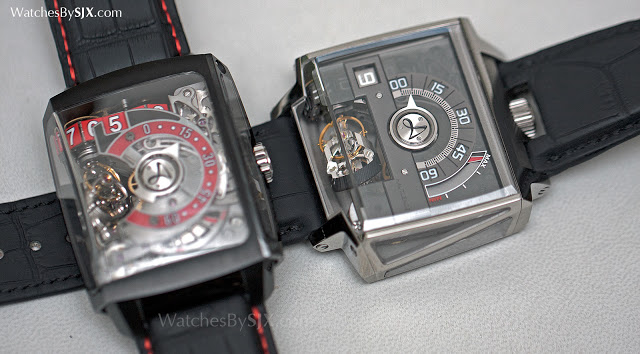Hands-On with the Hautlence Vortex “Concept d’Exception”, Containing as Many Parts as a Grand Complication (with Original Photos & Price)

Featuring jumping hours on a chain linked to a rotating escapement, the Vortex puts the most complicated Hautlence movement inside a newly designed titanium case with sapphire crystals all round.
Established to develop new methods of showing the time, Hautlence first launched its flagship movement in the HL2.0 in 2010 (above left). The Vortex is an improvement on that, with a large, angular case that contains the tweaked movement that retains its signature features – a retrograde minutes, jumping hours and a escapement that rotates every hour. Made up of 552 parts – equivalent to the number of parts in grand complication with minute repeater, perpetual calendar and tourbillon – the HLR2.0 movement is a complex beast that looks the part. The minutes are indicated on a semicircle across the dial, with the power reserve indication running from one to three o’clock. A grey tinted sapphire dial covers most of the front of the movement, but the display back reveals all of it.
Once the minute hand hits the “60” mark, it jumps back to “00”. Simultaneously, the hour numeral in the window at nine o’clock jumps. It doesn’t quite jump instantaneously as in traditional jump hour, but moves deliberately and purposefully, with a little bounce at the end.
Bevel gears translate the lateral motion of the gear train into the vertical motion of the escapement. It turns 60 degrees each time the hour changes, making four complete revolutions every 24 hours.
| The skeletonised balance wheel and hairspring are made by Mimotec via LIGA photolithography |
The movement is finished with a dark grey ruthenium coating, with gilded gears exposed through some shrewd open working providing contrast. Unusually for such a movement with a time display that requires significant amounts of power to move, it is self-winding, with a 40-hour power reserve. That’s possible because it has two mainsprings, one dedicated to keeping the time and the other solely to power the movement of the time display.
At 52mm wide and 50mm in length, the Vortex is extremely large. Larger in fact than the HL2.0 it succeeds. However, because the case is oriented horizontally on the wrist, rather than vertically as in the HL2.0 it wears better. But being titanium it is relatively lightweight. Conceived by Parisian design studio BBDC, whose partners worked with Hautlence co-founder Guillaume Tetu at TAG Heuer, the case is actually a sleeve with openings on the top and bottom. Plates with the lugs are screwed onto each end to close the case. The movement is mounted on the bottom plate, inserted into the case sleeve, then the top plate closes off the top.
The angular form of the case is inspired by glass-covered skyscrapers, which is why six crystals cover almost every surface, revealing the movement from almost every angle. Because the crystals are so large, and also angled in front, they are attached to the case via thin film adhesive.
Limited to 88 pieces in titanium (with other case metals to come), the Vortex has a price tag of SFr160,000 before taxes.
| The Vortex (left) with the HL2.5 |